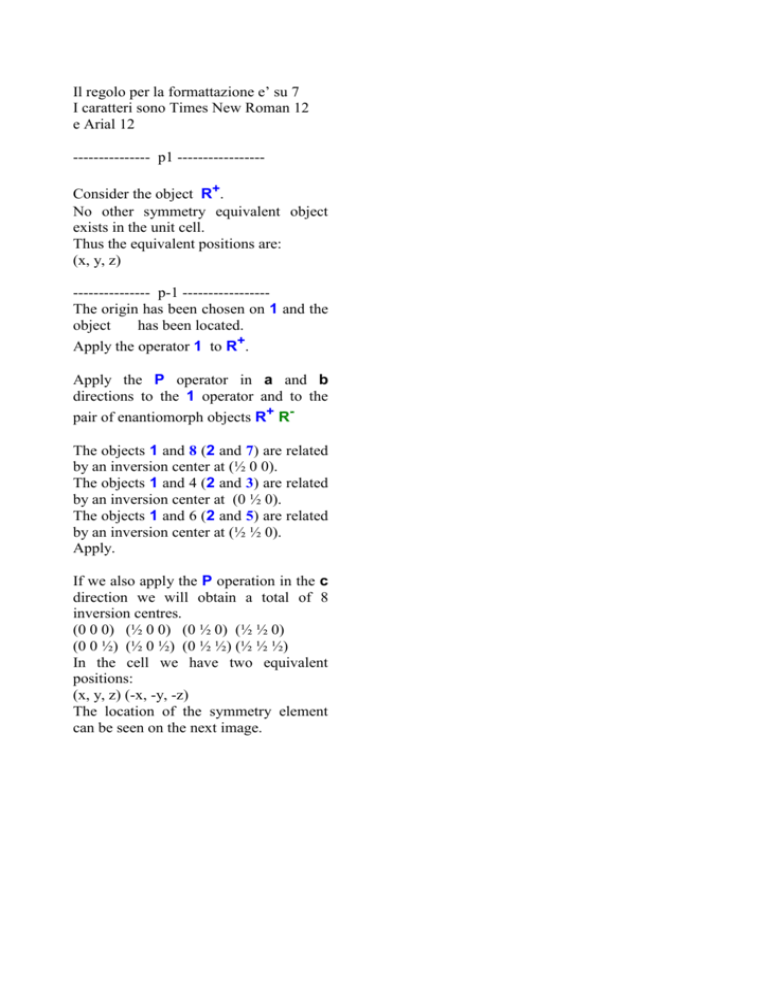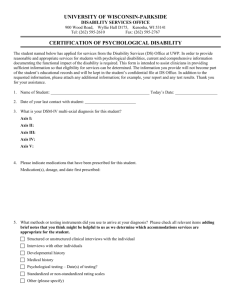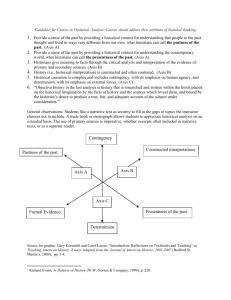We choose the origin on the binary axis (the b axis)
advertisement

Il regolo per la formattazione e’ su 7 I caratteri sono Times New Roman 12 e Arial 12 --------------- p1 ----------------Consider the object R+. No other symmetry equivalent object exists in the unit cell. Thus the equivalent positions are: (x, y, z) --------------- p-1 ----------------The origin has been chosen on 1 and the object has been located. Apply the operator 1 to R+. Apply the P operator in a and b directions to the 1 operator and to the pair of enantiomorph objects R+ RThe objects 1 and 8 (2 and 7) are related by an inversion center at (½ 0 0). The objects 1 and 4 (2 and 3) are related by an inversion center at (0 ½ 0). The objects 1 and 6 (2 and 5) are related by an inversion center at (½ ½ 0). Apply. If we also apply the P operation in the c direction we will obtain a total of 8 inversion centres. (0 0 0) (½ 0 0) (0 ½ 0) (½ ½ 0) (0 0 ½) (½ 0 ½) (0 ½ ½) (½ ½ ½) In the cell we have two equivalent positions: (x, y, z) (-x, -y, -z) The location of the symmetry element can be seen on the next image. --------------- p2 ----------------The origin has been chosen on the binary axis (the b axis) and the object has been located. Apply the operator 2 to . Apply the operator P in the a and b directions to the binary axis and to the pair R+ R-. The pair (1,3) is referred to the pair (8,6) by the two-fold axis (½ y 0) . The application of P also along the c direction defines a total of 4 two-fold axis: (0 y 0) (½ y 0) (0 y ½) (½ y ½). Apply. The two equivalent positions in the unit cell are: (x, y, z) (-x, y, -z) The location of the symmetry elements can be seen in the next image. --------------- c2 ----------------The origin has been chosen on the binary axis (the b axis) and the object has been located. Apply the operator 2 to . Apply the operator C in the a and b directions to the binary axis and to the pair R+ R-. The object 1 is referred to object 10 by a 21 axis along b at ¼ of a. Object 8 is referred to object 9 by a 21 axis along b at ¾ of a. The periodicity along the direction c defines a total of 4 two-fold axis: (0 y 0) (½ y 0) (0 y ½) (½ y ½) and 4 screw axis : (¼ y 0) (¾ y 0) (¼ y ½) (¾ y ½) Apply. The four equivalent positions in the unit cell are: (x, y, z) (-x, y, -z) (x, y, z) + ( ½, ½, 0) = (x+½, y+½, z) (-x, y, -z) + ( ½, ½, 0) = (-x+½, y+½, -z) The location of the symmetry elements is thus accomplished. Note: the space group C2 coincides with C21. --------------- pca21 ----------------The origin has been chosen at the intersection of the glide plane c normal to a and of the glide plane a normal to b. The object has been located. To apply the operator c click on Next. Apply the operator a to the pair of located objects. Apply the operator P to the located objects. The symmetry elements are localized as in the next figure. For the space group diagram (objects omitted) click on Next. The International Tables prefer to choose the origin on the screw axis. To obtain the conventional diagram click on Next. --------------- p4 ----------------The origin has been chosen on the fourfold axis (along the c axis) and the object has been located. Apply the operator 4 to . Apply the operator P in the a and b directions to the four-fold axis and to the four objects R+. The objects 1, 2, 3, 4 are referred to the objects 11, 12, 9, 10 respectively by the binary axes (0 ½ z). Apply also for the other pairs of objects. The four equivalent positions in the unit cell are: (x, y, z) (-x, y, -z) (-y, x, z) ( y, -x, z) The location of the symmetry elements can be seen in the next image.








